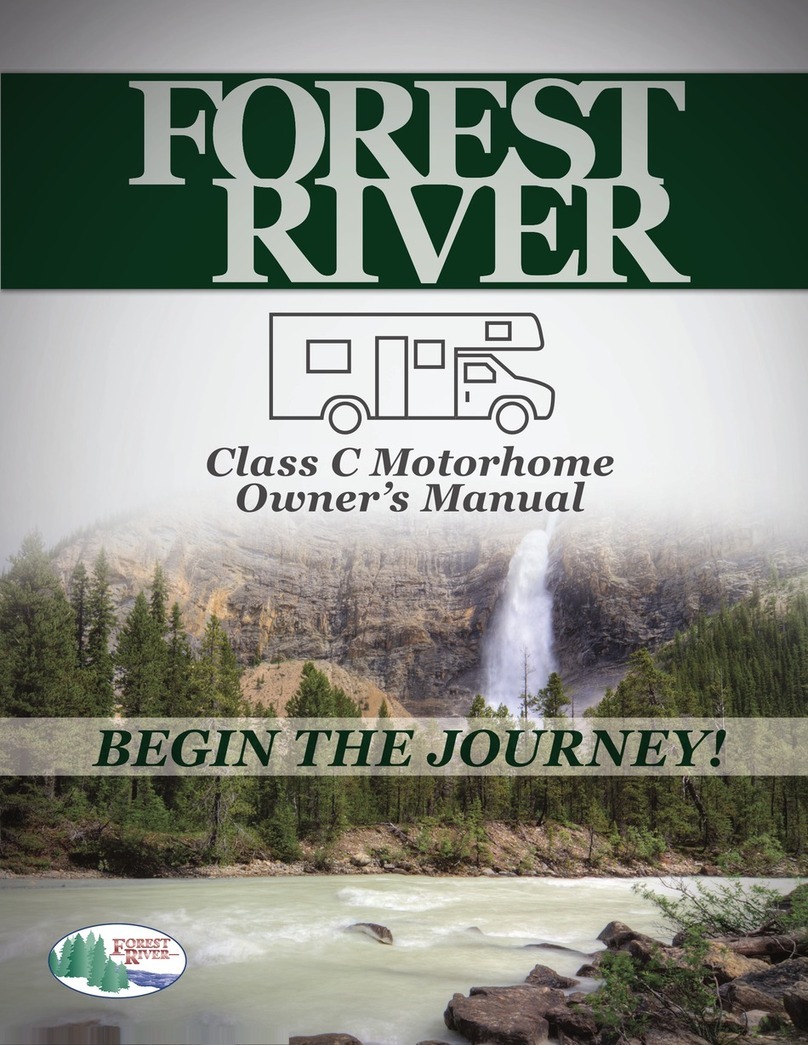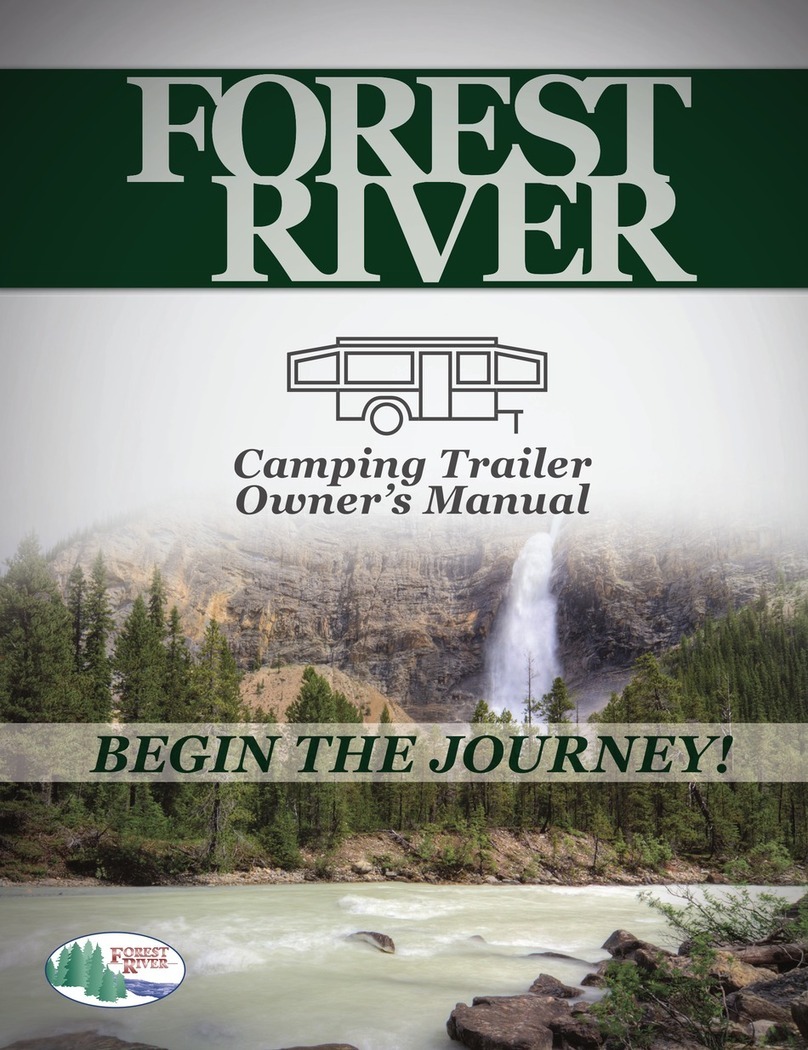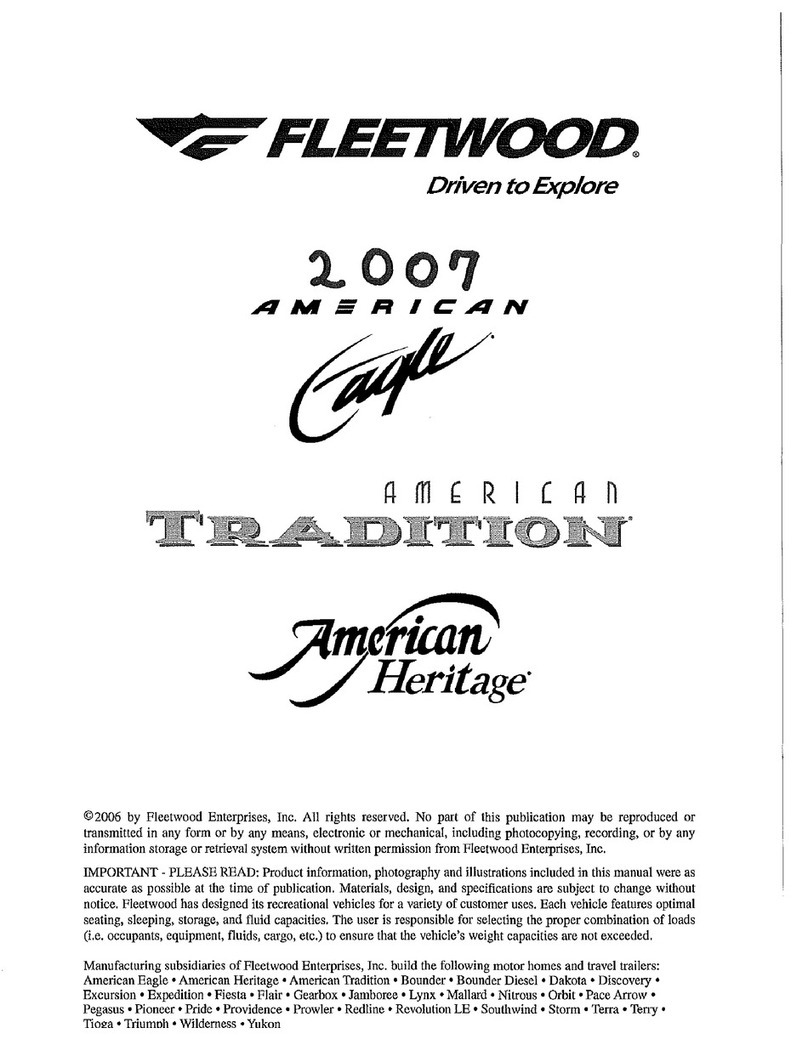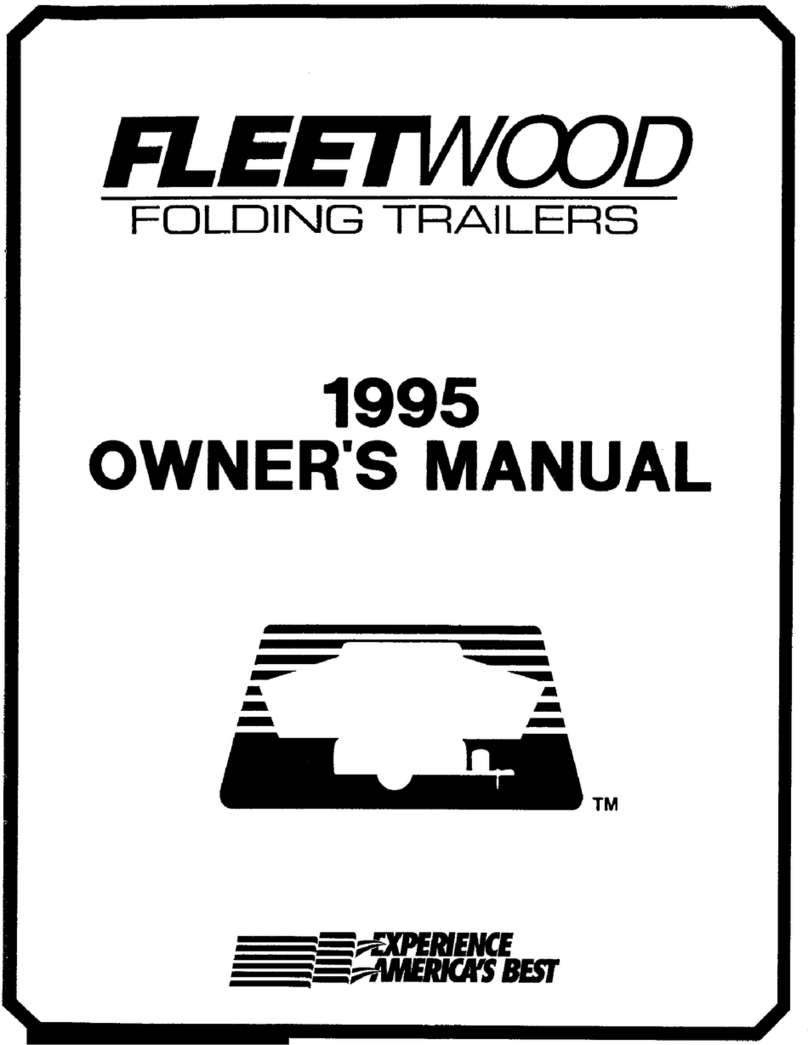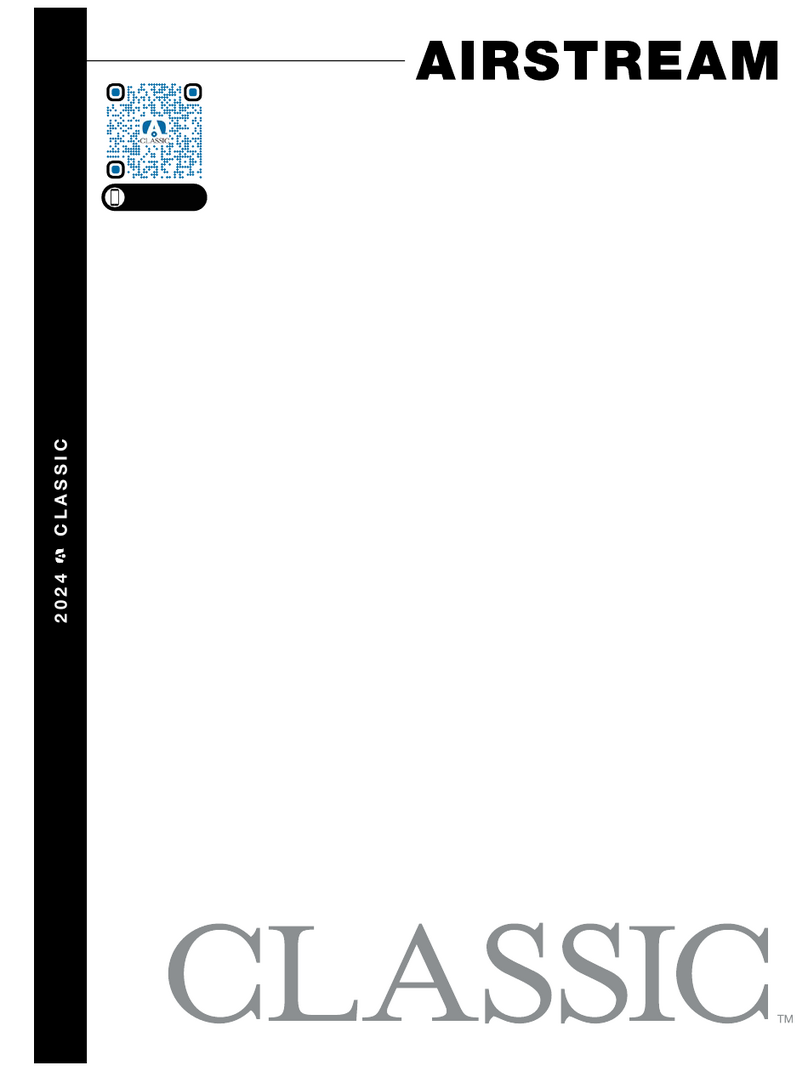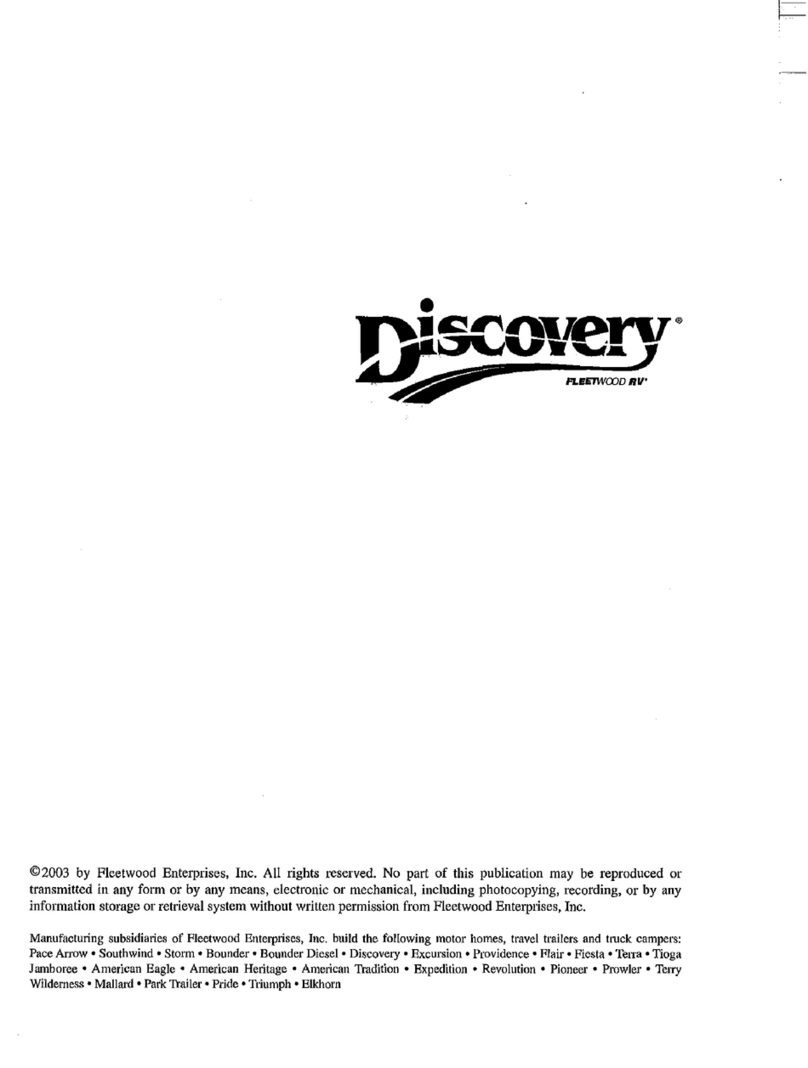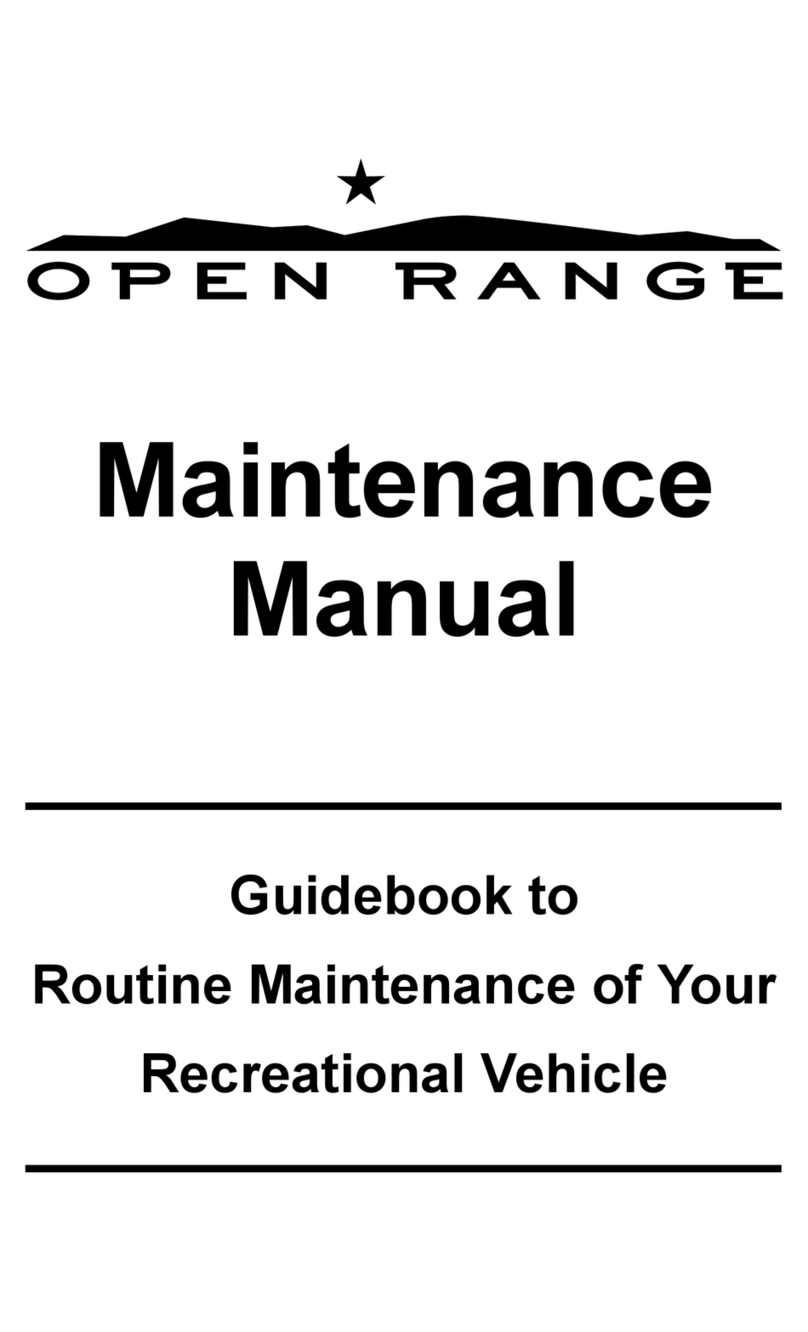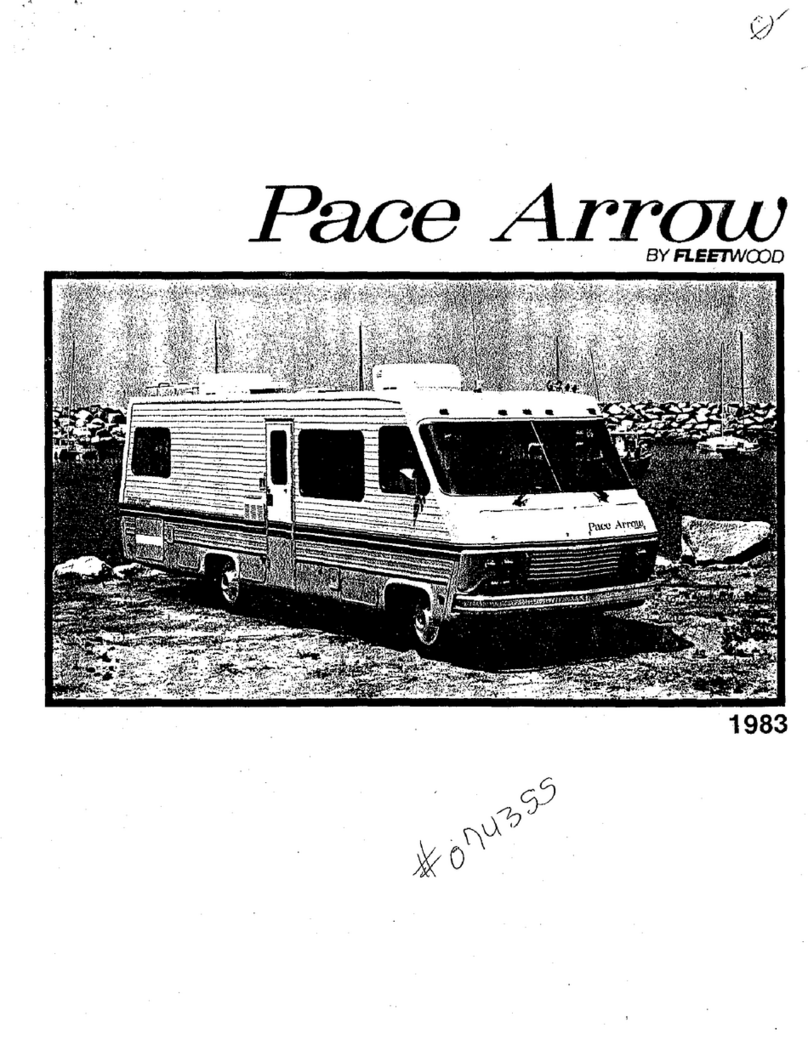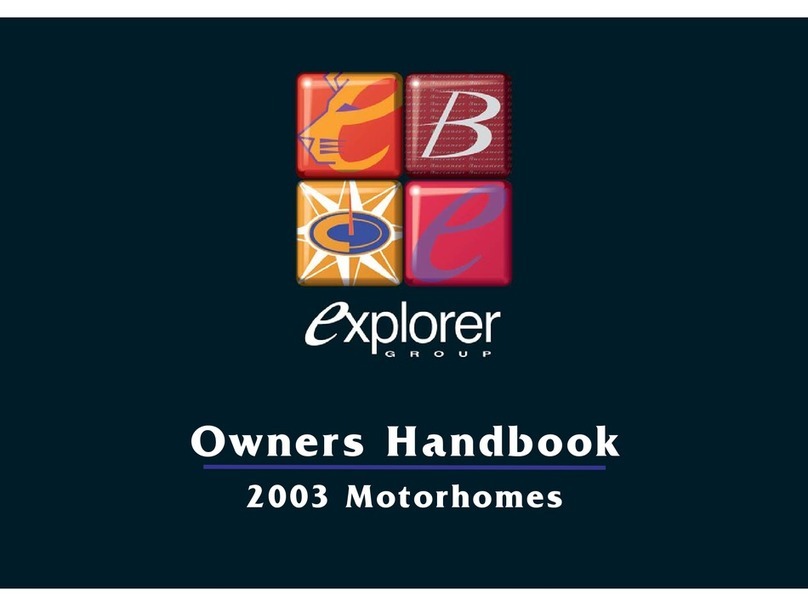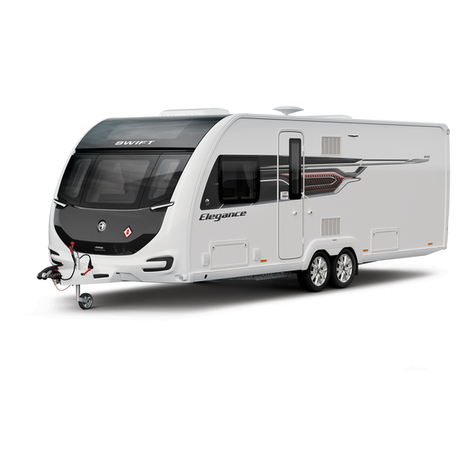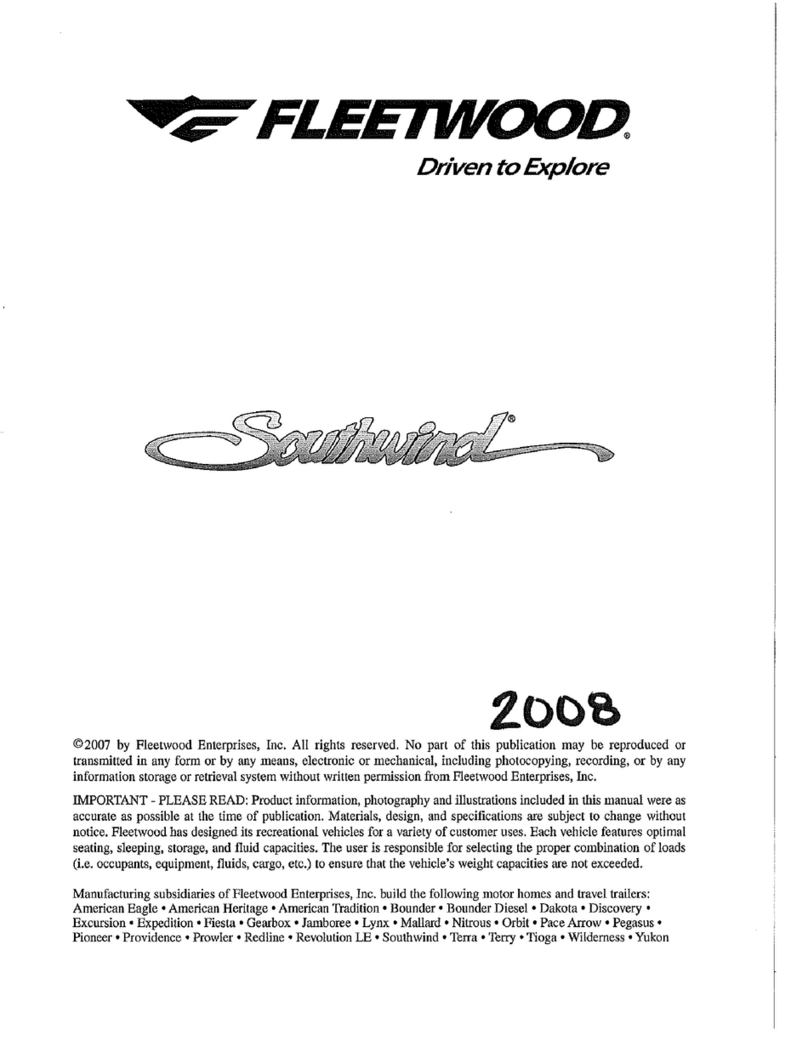forest river Flagstaff 2015 User manual

www.forestriverinc.com
Begin the Journey!
BEGIN THE JOURNEY!
Camping Trailer
Owner’s Manual
Camping Trailer
Owner’s Manual
Camping Trailer
© 2014 Forest River, Inc., a Berkshire Hathaway company. 09/14
Forest River Interactive Mobile Manuals
Download your Forest River mobile app or visit our dynamic online manual to
enhance your ownership experience. These interactive options provide incredible
ease and insight into use, maintenance and enjoyment of your Forest River product.
Ranging from “How-To” videos, pictures and illustrations of various components,
systems and features to fully searchable content and downloadable PDFs for
individual component owner’s manuals, answers are always just a click away.
Visit www.forestriverinc.com/manuals or scan
the QR Code to access even more information on your
Forest River product. Never be without your manual again!
OwnersManualCovers.indd 13-14 8/20/2014 8:32:18 AM

Welcome Letter
Welcome Home!
Thank you for selecting a Forest River tent camper, and welcome to the lifestyle that gives you the freedom to travel
and enjoy camping fun whenever you wish.
Your Forest River tent camper complies with the requirements set forth by the Recreational Vehicle Institute Associa-
tion, as well as various other federal and state agencies.
Items of quality, such as this tent camper, respond best to considerate treatment and care. Therefore, before using it,
we suggest that you review the entire contents of this manual. The material within has been prepared in sufficient detail
to be of maximum assistance, and the illustrations will be of considerable help when you are getting to know your new
camper.
Review this manual with your dealer. They should be able to answer any questions you may have. Read all the litera-
ture supplied with your new tent camper, including all warranty and warranty registration information. Remember to vali-
date the warranties by completing and mailing the individual warranty cards for each of the respective manufacturers.
Be sure your dealer has completed and returned your Forest River Tent Camper Warranty Registration Form.
Be sure your dealer has installed the propane container bracket, as well as the propane container and regulator. Check
that the connection has been made between the regulator and the propane manifold. Have your dealer explain the
operation of filling the propane container as well as how to check the system for leaks.
Keep this Owner’s Manual with the camper for easy reference, observing and following all instructions and warnings
associated with its use. Remember that accidents are usually caused by failure to observe simple and fundamental
safety rules or precautions. Accidents can be prevented by recognizing the cause of the accidents and by avoiding the
action, or inaction, that may lead to an accident. A careful owner is the best insurance against an accident. You can
also access this information by visiting www.forestriverinc.com and selecting the appropriate prompts or by download-
ing the mobile phone App at the Apple
TM
APP Store or Google Play
TM
for Android
TM
.
Your tent camper underwent a thorough inspection before it was shipped to the dealer. However, to ensure your com-
plete satisfaction, the dealer will perform an inspection of various components and the operating system of your camper
before you take delivery. Take time to walk through this inspection with your dealer. A walk around with your dealer will
help you become more familiar with your new tent camper and its components, while providing you with the assurance
that everything is in proper working order. If you are not familiar with tent camper towing, schedule a test drive with your
dealer. Ask any questions you may have at this time.
Your tent camper was designed for short-term and recreational use. It was not designed to be used as a permanent
dwelling. If you intend to use your camper as a permanent dwelling, it could cause your drapes, upholstery, and inte-
rior surfaces to deteriorate prematurely. This premature damage or wear, caused by permanent residency, may, under
the terms of Forest River’s warranty, be considered abnormal and abusive and COULD REDUCE YOUR WARRANTY
COVERAGE.
Should a problem develop for which you need assistance, contact your Forest River Inc. dealer. If you are experienc-
ing an appliance problem, check the appliance manufacturers’ information, located in the front of this manual, for infor-
mation regarding warranty work and/or for the location of an appliance service center.
If you experience a camper problem when traveling, and your camper is under warranty, and you cannot locate an
authorized service center, contact your Forest River Inc. dealer BEFORE having repairs performed at an independent
service center. Your dealer can advise you about what is covered under the terms of your warranty. If a warranty part
requires replacement, return the part, along with your invoice, to your local dealer. Doing so enables your dealer to note
what has occurred and ensures that you are properly reimbursed for your expenditures. Modifications made to the tent
camper without written authorization from the Forest River Inc. Warranty or Service Dept. can result in reduction or loss
of warranty coverage. Please be sure to contact your dealer before making such changes.
1

Some products described or displayed in this manual may be optional equipment, and not included with your camper.
Any special equipment, modifications, or additions made by, or at the request of, the customer, or any subsequent
owner, whether made at the factory or in the field, are not covered in this manual. We reserve the right to change the
construction, or material, of any part, at any time, without incurring the obligation to install such changes on previously
manufactured tent campers.
This Owner’s Manual was current at the time of printing; however, products are continually being upgraded and
improved; therefore, some differences may occur between the description in this manual and the product/s in your
camper. If differences do occur, follow the component manufacturer’s instructions provided with your Forest River Inc.
tent camper Owner’s literature packet.
We wish you many happy and adventurous days as you make great memories with your new Forest River Inc. tent
camper.
Travel Safely and...GO RV’ing!
2

Limited Warranty
Fold Down Tent Camper
SUMMARY OF WARRANTY
Forest River Inc. warrants, only to the original purchaser, that the tent camper is free from defects in materials and
workmanship. Warranty terms include service for 12 months from the original date of purchase for tent campers used
only for non-commercial purposes. Forest River Inc. further warrants, to the original purchaser, that the roof, tent and
frame are free from substantial defect, from the factory, in material and workmanship, for a period of five (5) years for
parts, and three (3) years for parts and labor, from the date of purchase, under normal use conditions, effective with
1996 models. This warranty does not apply to any defect in the aesthetics or physical appearance of the unit, nor to
normal deterioration of the soft trim and cosmetic items due to wear and exposure.
HOW TO OBTAIN WARRANTY SERVICE
Defects in materials and workmanship of the camper during the first 12 months will be repaired free of charge, if the
unit is returned, with both ‘to and from’ transportation charges prepaid, to an authorized Forest River Inc. dealer. Defects
in material or workmanship of the roof, tent or frame of the camper, during the first three years of the five-year warranty
period, will be repaired free of charge, if the part is returned, with prepaid ‘to and from’ transportation charges, to an
authorized Forest River Inc. dealer. For the remainder of the five (5) year warranty period, warranty parts will be
replaced, but necessary labor will be charged. If an authorized service center is not available in your area, refer to the
information on the inside back cover to arrange prompt repairs to your camper.
EXCLUSIONS
1. Forest River Inc. assumes no responsibility or liability for defects in workmanship or the operation of separately
warranted products. These products may be warranted by the individual manufacturers and a copy of their war-
ranties have been included in your owner’s packet. Separately warranted products will not be serviced, repaired
or replaced by Forest River Inc. If service or parts are required for these products, refer to the furnished list of
factory-authorized service centers. If the list is not available for the particular products, write or call the manufac-
turer concerned to obtain the location of the nearest service center.
2. Forest River Inc. does not warrant components manufactured by others, including, but not limited to, tires, appli-
ances, equipment, ranges, ovens, furnaces, batteries, axles, hubs, bearings, power converters, refrigerators,
burners, floors, and brake systems. These parts may or may not be warranted by their manufacturers; however,
Forest River Inc. assumes no obligations with regard to them.
3. This unit was expressly designed for use as a recreational vehicle and is not intended for use as a full-time sta-
tionary residence. Forest River Inc. makes no warranty with regard to normal and routine condensation.
4. Snow loads must be removed from the roof to avoid damage to the roof.
5. This warranty shall not apply to normal maintenance, such as greasing wheel bearings, tightening lug nuts, keep-
ing the areas sealed, where extrusions meet panels, etc., that the tent camper will require, nor to any damages
arising from abuse or the failure to have such maintenance performed.
6. Fabric items, such as canvas, canopies, window screening, vinyl windows, cushion and mattress covers, are not
warranted against leakage, tears, punctures, shrinkage, fading or soiling but are warranted only against defective
workmanship and materials. Installation of a roof air conditioner must be performed only at the designated area on
the roof, by an approved Forest River Inc. dealer, or the roof, lifter system, and related components will not be
warranted.
This product is a fold down tent camper and SHALL NOT be used for COMMERCIAL purposes OR RENTALS. Abuse,
neglect, or operation over unimproved roads will void this warranty. Forest River Inc. makes no warranty with regard to
any product not registered and normally used in the United States of America or Canada.
DISCLAIMER OR DAMAGES
You and any other user of Forest River Inc. products and any person to whom this unit is transferred, and any person
who is an intended or unintended beneficiary of this unit, shall not be entitled to any consequential or incidental dam-
ages, including, without limitation, loss of use of the unit, inconvenience, food, lodging, damage to personal property,
lost income or earnings.
Some states do not allow the exclusion or limitation of incidental or consequential damages, and this may not apply to
you.
3

DISCLAIMER AND LIMITATIONS OF IMPLIED WARRANTIES
Forest River Inc. limits all implied warranties of fitness for a particular purpose, and merchantability, to the warranty
period of one year. No warranties, expressed or implied, extend beyond the one year warranty period. No person has
the authority to extend, enlarge, or modify this warranty. No action to enforce this warranty may be commenced more
than six months after expiration of the warranty period.
Some states do not allow limitations on how long an implied warranty may last, so the above limitation may not apply
to you. This warranty gives you specific legal rights, and you may also have other rights which vary from state to state.
FOREST RIVER’S OBLIGATION
Forest River Inc. will remedy substantial defects in materials and workmanship caused by Forest River Inc. Forest River
Inc. shall elect to remedy the defect by either repair, replacement or refund, at Forest River’s discretion. Warranty ser-
vice can only be obtained at Forest River’s authorized dealers and service centers. All costs incurred in transporting
this tent camper for warranty service shall be borne by you. Forest River Inc. shall remedy the defect within a reason-
able time, not to exceed sixty (60) days, after delivery by you. All of Forest River’s expenses in remedying the defect
shall be borne by Forest River Inc.
YOUR OBLIGATIONS
To validate this Warranty, be sure your dealer completed and returned the owner’s registration within ten (10) days of
purchase. The return of this registration form is a condition precedent to warranty coverage. Failure to return the com-
pleted form to Forest River Inc. will invalidate this warranty. You shall deliver this fold down tent camper for warranty
service within a reasonable time, after discovery of the defect, and in no event after expiration of the Warranty period,
as set forth above. All expenses incurred by you in obtaining warranty service shall be borne by you. You may obtain
a list of authorized service centers to perform warranty service by contacting Forest River Inc. at the address below.
PARTS AND DESIGN CHANGES
Forest River Inc. may make parts and design changes from time to time without notice and repairs or replacements may
be made with new or different parts.
WARRANTY REGISTRATIONS
Your warranty registration records should be completed and delivered to the manufacturers of component parts as they
may be a condition of this warranty.
This Forest River Inc. Warranty is void unless your warranty registration is returned to Forest River Inc. at the address
listed on the back cover of this Owner’s Manual.
4

Limited Lifetime Warranty
Fold Down Camper Lifter System
SUMMARY OF WARRANTY
Forest River Inc. extends to the original retail purchaser (You) a limited warranty on its lifter system in Forest River Inc.
recreational vehicles against defects in material or workmanship for the lifetime of the recreational vehicle.
COMPANY’S OBLIGATIONS
If the lifter system is determined to be defective during the warranty term, Forest River Inc. will remedy the defect with-
out charge within a reasonable time after receipt of written notice either by repair or replacement. Warranty service may
be obtained from Forest River Inc. or its authorized dealers, or persons designated by Forest River Inc. In the event
you have a defective lifter system repaired by an unauthorized service person and said repairs are covered by this
Warranty, Forest River Inc. shall be liable only for costs of those repairs up to the amount that Forest River Inc. would
have incurred if Forest River Inc. or an authorized dealer had made the repairs.
Warranty performance will commence within a reasonable time after Forest River’s receipt of written notice of the defect
and will be completed within a reasonable time, subject to availability of parts and scheduling.
ITEMS EXCLUDED FROM WARRANTY
This warranty does not cover defects caused by:
1. Negligence in operation and maintenance.
2. Misuse of lifter system.
3. Damage not resulting from defect or malfunction (act of God).
4. Any damage that is caused by or related to any alteration of a Forest River Inc. lifter system.
5. Claims relating to unauthorized repairs, damage or defects.
6. Claims relating to the power lift system if unit is so equipped.
PURCHASER’S OBLIGATION
You shall give written notice to Forest River Inc. at the address set forth herein within a reasonable time after discov-
ery of the defect. This written notice should contain the following information:
1. Your name and mailing address.
2. Proof of date of purchase.
3. Model, year and serial number of the camper.
4. Name and address of dealer from whom the camper was purchased.
5. Description of the defect.
All costs incurred by you in transporting the Forest River Inc. system for warranty service shall be borne by you. No
action to enforce this Warranty shall be commenced later than three (3) months after the expiration of the warranty
period.
DISCLAIMER OF CONSEQUENTIAL OR INCIDENTAL DAMAGES
Repair or replacement under this warranty is your exclusive remedy. Forest River Inc. shall not be liable for any inci-
dental or consequential damage, resulting from any defect in the lifter system. Some states do not allow the exclusion
or limitation of incidental or consequential damages so the above limitation or exclusion may not apply to you.
LIMITATION AND DISCLAIMER OF IMPLIED WARRANTIES
Forest River Inc. expressly limits all implied warranties to the warranty period. Forest River Inc. expressly disclaims, with
respect to the Forest River Inc. lifter system, all implied warranties of merchantability and all implied warranties of fit-
ness for a particular purpose after expiration of the warranty period. There is no warranty of any nature made by For-
est River Inc. beyond that contained in this warranty. No person has authority to enlarge, amend, or modify this
warranty.
Some states do not allow limitations on how long an implied warranty lasts, so the above limitation may not apply to you.
This warranty gives you specific legal rights, and you may also have other legal rights which vary from state to state.
PARTS AND DESIGN CHANGES
Forest River Inc. may make parts and design changes from time to time without notice and repairs or replacements may
be made with new or different parts.
All inquiries regarding this Warranty should be sent to the address listed on the back cover of this Owner’s Manual.
5

INTRODUCTION .............................1
Welcome Letter ..........................1
Limited Warranty ..........................3
Limited Lifetime Warranty ...................5
CUSTOMER INFORMATION .....................7
Manufacturers’ Warranties ...................7
Dealer’s Responsibilities ....................7
Customer’s Responsibilities ..................8
Warranty/Pre-Delivery (Sample) Forms .........9
Contact Us .............................10
Coach-Net™ Roadside Assistance ............11
IDENTIFICATION AND SAFETY ..................12
Vehicle ID Decals and Plates ................12
Vehicle Serial Number Label ................12
Safety Regulations and Propane .............12
Safety Devices ..........................13
Fire Safety .............................14
Tire Safety .............................15
WEIGHING, LOADING AND TOWING ............18
Weight Terminology .......................18
Weighing Your Camping Trailer ..............18
Pre-Travel Check ........................23
Loading Tips ............................24
Packing For Travel .......................24
LIVING QUARTERS ..........................25
Prolonged Occupancy .....................25
Condensation and Humidity .................25
Propane ...............................25
Electrical System ........................30
Fuses and Circuit Breakers .................31
PLUMBING ...............................32
Fresh Water ............................32
Water Center Panel .......................32
Traveling with Water ......................32
Water Pump ............................33
Sanitizing Portable Water System ............33
Toilet .................................34
Winterization and De-winterization ............34
Water System Maintenance and
Troubleshooting .........................35
APPLIANCES ..............................36
Range ................................36
Refrigerator ............................37
Furnace ...............................37
Water Heater ...........................37
CARE AND MAINTENANCE ....................38
Exterior ................................38
Fiberglass and Aluminum Siding ............38
Seals and Adhesives .....................38
Frame ...............................38
Wheels and Tires .......................39
Brakes and Wheel Bearings ...............39
Jack Post, Dolly Wheel, and Coupler .........39
Propane System ........................39
Tent Maintenance ........................39
Tent Material ...........................39
Tent Vinyl Maintenance ...................39
Crank-Up Lift System ....................39
Interior ................................40
Appliances, Sink and Countertop ............40
Cushions .............................40
Curtains ..............................40
Vinyl Floor Covering .....................40
Wood Surfaces and Pre-Finished Panels ......40
Water System ..........................40
Electrical System .......................40
Bed Slides ............................40
Roof Vent .............................40
ABS Plastic ...........................40
Wintertime Use and Storage ...............41
Care and Maintenance Charts ...............42
Propane System .........................42
Effects of Formaldehyde ...................44
WaterPur™ Water Treatment System ..........45
INDEX ...................................47
TABLE OF CONTENTS
6

Manufacturers’ Warranties
For any components with separate warranties on your
tent camper, be sure to check the literature supplied by
the manufacturer to see if they require you to register
your purchase with them to validate their warranty. These
warranties generally apply only to the original purchaser
of the tent camper. Forest River Inc. recommends that
you send the various warranty registration cards or forms
immediately before any time constraints on registration
expire, possibly voiding your warranty.
Manufacturers’ literature is supplied with the owner’s
information packet in newly delivered units. Only those
products and options, which are installed on your
camper, will be included in this packet. If you have ques-
tions regarding this literature, discuss them with your
dealer during the pre-delivery inspection and report any
literature shortage at that time.
General Warranty Information
The appliances in your tent camper will provide home-
like convenience while traveling. They have been
designed and tested by their manufacturers for maximum
service in a tent camper application. Each appliance in
your camper is covered by Forest River’s comprehensive
warranty as well as being warranted by its respective
manufacturer.
It is important that you review all the literature provided
in the manufacturers’ information packet. Fill out and mail
any warranty registration cards or forms required by the
appliance manufacturer at this time. Failure to do so
could void your warranty. Be sure to have your dealer go
over the operation of the appliances with you, and note
any shortage of literature you may have at that time.
It is important also that you carefully read all the manu-
facturers’ information provided regarding both operation
and maintenance of the appliances. Pay close attention
to all safety precautions given and be sure to follow
them. Keep all literature, including this manual, with the
tent camper for easy reference.
If service on any appliance is required, contact your
dealer, or an authorized service representative of the
appliance manufacturer. Appliances available in the
camper include the range, refrigerator, water heater, and
optional furnace. Operating instructions can be found in
the literature provided with each appliance in the manu-
facturers’ information packet.
NOTE:
Be sure your dealer completes the retail pre-delivery
inspection form and Warranty Registration form (refer to
page 8) supplied with your camper, within 10 days of
purchase, and that both you and the dealer sign and date
them before returning them to Forest River to register
your warranty.
Dealer’s Responsibilities
1. The selling dealership is responsible for inspecting
both factory and dealer installed components for
proper operation. This is known as the pre-delivery
inspection and systems check.
2. Your dealer is required to provide a thorough and
complete walk-through demonstration. This demon-
stration should provide a good understanding of
how your new RV operates.
3. The owner’s information packet should be pre-
sented at this time. This information should include
all warranty cards, component information, opera-
tion and maintenance instructions relating to your
new unit.
4. All component warranty forms should be discussed
and/or completed at this time. Your selling dealer
should assist you in understanding any and all lim-
ited warranty provisions to help you avoid loss of
warranty for any reason. Ask any questions you
may have before leaving the dealership.
5. Your dealer should provide you with information
concerning any need for service for your unit,
whether in or out of their area. They should provide
contact numbers for the dealership both during and
after hours along with contact information for the
correct Forest River division.
CUSTOMER INFORMATION
7

Customer’s Responsibilities
1. Regular and proper maintenance - As the owner,
you have the responsibility to properly maintain
your recreational vehicle. Be sure you have service
performed in a timely manner; don’t ignore a prob-
lem. It isn’t always necessary to take your unit to a
service center; sometimes a phone call is all that is
needed. The service technicians can advise you.
2. Familiarize yourself with your RV. Observe all the
component manufacturers’ instructions regarding
the use and service of their products.
3. Complete and send in all the warranty cards. Doing
so may help you avoid conditions arising from
neglect that are not covered under warranty.
NOTE:
Modifications to your RV, without written authorization
from Forest River Inc., could result in reduction or loss of
warranty coverage. Contact your dealer before making
such changes.
The following is a list of suggestions to assist you in
avoiding most warranty issues:
1. Read your warranties and review them with your
selling dealer. The dealer’s obligation is to educate
you regarding the proper and safe operation of your
RV and all its components.
2. Be sure to inspect the entire unit and note any ser-
vice issues.
3. Locate all paperwork and ask any questions you
may have before leaving the dealership.
NOTE:
Forest River Inc. wants you to have the best possible
adventure with your new RV. To get the most enjoyment
out of your new RV and to ensure you fully understand
how your new recreational vehicle operates, please
address immediately any questions or concerns you may
have regarding your RV with your dealer before using
your unit for the first time.
NOTE:
Use your new recreational vehicle responsibly. Your
camper was not designed to be used as a permanent
dwelling, but for short-term and recreational use. If you
intend to use your RV as permanent housing, it could
cause premature wear on your appliances, furnace,
water systems, carpet, drapes, upholstery, bedding and
interior surfaces. This premature wear caused by perma-
nent residency may be considered abnormal or abusive
use and could reduce or in some cases void your war-
ranty coverage.
Coach-Net ®
When you take delivery of your new
Forest River Inc. recreational
vehicle, you are provided with an
emergency roadside assistance ser-
vice - free. We’ve teamed up with
the largest RV emergency roadside
assistance company in the country
to give you immediate access to
fast, dependable service when and
where you need it. This is a compre-
hensive emergency roadside ser-
vice that is available to you 24/7,
around the clock.
For complete details regarding how
to access your Forest River emer-
gency roadside assistance and
product support plan benefits, call
1-877-801-0333 or see the informa-
tion in the back of this manual.
THE FOLLOWING IS ADDED AS A REQUIREMENT
OF THE NATIONAL HIGHWAY TRAFFIC SAFETY
ADMINISTRATION (NHTSA).
If you believe that your vehicle has a defect which
could cause a crash or could cause injury or death, you
should immediately inform the National Highway Traffic
Safety Administration (NHTSA) in addition to notifying
the manufacturer.
If NHTSA receives similar complaints, it may open an
investigation and if it finds that a safety defect exists in
a group of vehicles, it may order a recall and remedy
campaign. However, NHTSA cannot become involved
in individual problems between you, your dealer, or the
manufacturer.
To contact NHTSA, you may either call the auto safety
hot line, toll-free at 1-888-327-4236, for hearing
impaired (TTY) call 1-800-424-9153. You may write to:
NHTSA, 400 Seventh Street SW, Washington, D.C.
20590. You can also obtain additional information about
vehicle safety from their website, http://
www.safercar.gov.
NOTE:
If you have repairs performed by a non-Forest River
repair center, you still must return the defective part to
Forest River to be considered for warranty repair reim-
bursement.
CUSTOMER INFORMATION
8

Warranty/Pre-Delivery (Sample) Forms
CUSTOMER INFORMATION
9

Contact Us
Forest River Wants Satisfied Customers
Your satisfaction and goodwill are important to both your
RV dealer and to Forest River. If you experience a prob-
lem and you have exhausted all attempts to rectify the
situation with your RV dealership, you may consider con-
tacting the Forest River Warranty/Customer Service rep-
resentative. Contact information is provided on the back
inside cover of the Owner’s Manual.
When calling, please have the following information
ready:
1. Your I.D. number.
2. Name and location of your selling dealer.
3. The date of your purchase.
4. The nature of the problem.
CUSTOMER INFORMATION
10

Coach-Net™ Roadside Assistance
Emergency Roadside Assistance
Benefits
On-Site Emergency Roadside Assistance includes services such as towing, at tire assistance, delivery of
emergency uids, jump start/battery boost and lockout/locksmith. Winch out or extraction services required in order
to tow the disabled vehicle are covered for one man, one truck for two hours or two men, two trucks for one hour
up to 100 feet o a maintained road or in a commercial campground.
RV Technical Assistance Hotline is staed with certied technicians and factory-trained representatives who
understand the unique needs of RVers. Having access to a RV expert who can guide
you through many common
operational issues over the phone is priceless.
RV Service Appointment Assistance is a hassle -free way of arranging for a service appointment when and where
you travel. We make an appointment for you and give you directions and a time that ts your schedule.
Emergency Trip Interruption – Should your vehicle become disabled due to a collision more than 100 miles from
home you may be reimbursed up to $2000 ; reimbursement up to $300 for the rental of an automobile, up to
$1000 for airline tickets, up to $300 for meals and up to $400 for hotel/motel lodging to the extent made
necessary by the conditions of the emergency and subject to any limitations under applicable state law.
Emergency Messenger Service – Stay in touch with family and friends with no cost emergency message service.
Nationwide Trip Routing – Make your next trip more enjoyable with custom trip routing and full color maps. We
provide easy-to-follow maps and directions, travel tips, and a list of interesting places to see and much more.
Coverage
Coverage is available for one year on your new RV and one additional family automobile or truck identied as
eligible for the plan. Assistance is available 24 hours a day, 7 days a week by calling the toll-free number on
your ID Card. Services are available on a “sign & drive” basis throughout the U.S. and Canada, and services are
available in Mexico but limitations apply.
When you take delivery of your new Forest River RV, you can travel
worry-free knowing you have an RV technical expert and
emergency roadside assistance just a phone call away. We’ve
teamed up with one of the largest, independently owned
emergence roadside assistance providers in the country to give
you immediate access to fast, dependable service when and where
you need it. Coach-Net RV Technical & Roadside Assistance has
been included in your purchase - FREE for 1 year!
For further details regarding how to access your
Emergen cy R oadside Assistance, please call
1-877 -801 -0333.
Benets and services provided by NMC -RV, Inc. This is a brief summary of the program benets.
Limitations, restrictions and exclusions apply. If there are any conicts between this document and the
Guide, the Guide shall govern.
CUSTOMER INFORMATION
11

LEGEND
Listed below are symbols and descriptions you will find
throughout this manual. They are used to alert you to
possibly dangerous or hazardous situations. When you
see these symbols, please read them carefully and fol-
low the instructions to help prevent damage to your
recreational vehicle and for your personal safety.
DANGER DANGER! (Indicates a hazardous situ-
ation which, if not avoided, will result in
death or serious injury.) This sign is
commonly RED.
WARNING WARNING (Indicates a hazardous
situation which, if not avoided, could
result in death or serious injury.) This
sign is commonly ORANGE.
CAUTIONCAUTION (Indicates a hazardous situ-
ation which, if not avoided, could result
in vehicle damage or minor to moder-
ate injury.) This sign is commonly YEL-
LOW.
Vehicle ID Decals and Plates
RECREATIONAL VEHICLE DATA PLATE
The camper serial number label is mounted on the front
road side of the camper.
Vehicle Serial Number Label
NOTE:
Be prepared to supply model number, serial number and
year when ordering parts or requesting specific informa-
tion regarding your RV.
Forest River Inc. recommends that you keep a copy of
this information separate from the camper in the event
that theft or vandalism requires you to supply a copy to
the authorities.
Decals and data plates, used throughout the camper, aid
in its safe and efficient operation; others give service
instructions. Read all decals, data, and instruction plates
before using your new camper. If a decal, data, or
instruction plate becomes damaged, painted over or
removed, it needs to be replaced.
Safety Regulations and Propane
The following warnings are posted throughout your rec-
reational vehicle to provide information on propane
safety. They have been installed not only because of the
requirement to do so, but also as a constant reminder to
occupants of the recreational vehicle to exercise proper
caution when using or being around propane appliances
and equipment. We are listing them here so you may
study them and be sure that you and your family under-
stand and follow them.
WARNING
Do not place propane cylinders inside the vehicle.
Propane cylinders are equipped with safety
devices that relieve excessive pressure by dis-
charging propane to the atmosphere. Propane is
highly flammable. Failure to comply may lead to
fire or explosion and result in death or serious
injury.
DANGER
Propane cooking appliances need fresh air for safe
operation. Before operating:
Open vents or windows slightly or turn on the
exhaust fan prior to using the cooking appliance.
Propane flames consume oxygen which must be
replaced to ensure proper combustion. Improper
use may result in death or serious injury.
A warning label is located in the cooking area to
remind you to provide an adequate supply of fresh
air for combustion. Unlike homes, the amount of
oxygen supplied is limited due to the size of the
recreational vehicle, and proper ventilation when
using the cooling appliance(s) will avoid dangers
of asphyxiation.
DANGER
Do not use propane cooking appliances for com-
fort heating. Failure to comply may lead to carbon
monoxide poisoning which can lead to death or
serious injury.
DANGER
Do not store propane containers, gasoline, or
other flammable liquids inside the vehicle as a fire
or explosion may result.
IDENTIFICATION AND SAFETY
12

DANGER
A warning label is located near the propane con-
tainer. This label reads:
DANGER
Do not fill propane container(s) to more than 80
percent capacity.
A properly filled container will contain approxi-
mately 80 percent of its volume as liquid propane.
Overfilling the propane container can result in
uncontrolled propane flow, which can cause fire or
explosion and result in death or serious injury.
DANGER
IF YOU SMELL PROPANE:
1. Extinguish any open flames and all smoking
materials.
2. Shut off the propane supply at the container
valve(s) or propane supply connection.
3. Do not touch electrical switches.
4. Open doors and other ventilating openings.
5. Leave the area until the odor clears.
6. Have the propane system checked and leak-
age source corrected before using again.
Ignition of flammable vapors could lead to a
fire explosion and result in death or serious
injury.
Safety Devices
WARNING
Never ignore alarms on safety devices. If the alarm
sounds and you are not absolutely certain of the
source, get everyone out of the recreational
vehicle immediately.
•Always have a plan of escape. Update and practice
your escape plan every six months.
•Have a meeting and discuss the plan, showing
everyone what to do including guests.
•Do not waste time by picking up valuables or getting
dressed. Sometimes seconds count!
•Vacuum any dust off the alarm weekly using the soft
brush attachment.
•DO NOT spray cleaning agents or waxes directly
onto the detector as it may cause damage to the
sensor.
Smoke Detector
•Smoke alarms may not have time to alarm before
the fire causes damage, injury or even death.
•A smoke detector works for only detecting smoke,
not fire.
•The alarm will sound only if smoke reaches the
sensor.
•Check the battery/s at least once a week while the
RV is in use.
•This unit will not alert hearing-impaired residents.
(Special alarms with flashing strobe lights are
needed for the hearing impaired.)
•Smoke alarms have a limited life and are not
foolproof.
•Never attempt to repair this unit; replace if faulty.
•Never disconnect the battery to silence the alarm.
WARNING
Smoke alarms may have an expiration date. Please
consult the individual Owner’s Manual or on-line at
www.forestriverinc.com.
IDENTIFICATION AND SAFETY
13

CO Detector
•The carbon monoxide detector is designed to detect
carbon monoxide from any source of combustion. It
is NOT designed to detect smoke, fire or any other
gases.
•This detector doesn’t work without batteries. DO
NOT remove batteries except for replacement.
•Test alarm each week while RV is in use and before
beginning a trip. Press the ‘TEST’ button. If the
alarm fails to sound, replace the unit immediately.
DO NOT attempt to repair.
•For more information, please consult the individual
Owner’s Manual or on-line at
www.forestriverinc.com.
Propane Detector
•This detector senses propane in the air, not smoke
or fire or other gases. It detects the presence of
propane at the sensor; explosive gas may be pres-
ent in other areas.
•Test your propane detector weekly. If the alarm is
located behind a closed door, it may not be heard.
•DO NOT attempt to repair the detector. If it fails the
test, change batteries. If it still does not function
properly, replace the entire unit.
•For more information, please consult the individual
Owner’s Manual or on-line at
www.forestriverinc.com.
Fire Safety
Fire safety is an important part of owning a recreational
vehicle. The following basic rules of fire prevention can
help eliminate the possibility of a fire.
1. Never store flammable liquids in the recreational
vehicle.
2. Never leave cooking food unattended.
3. Never smoke in bed and always use an ashtray.
4. Never allow children to play with propane or electri-
cal equipment.
5. Never use an open flame as a flashlight.
6. Have faulty or damaged wiring and electrical com-
ponents repaired immediately.
7. Never overload electrical circuits.
8. Locate any propane leaks and have them repaired
immediately.
9. Keep cooking surfaces clean and free from debris.
10. Don’t allow rubbish to accumulate.
11. Never clean with a flammable substance.
12. Spray fabrics annually with a flame retardant.
NOTE:
Be sure that everyone in your RV is familiar with the
location of all exits, including exit windows.
NOTE:
Make sure everyone is familiar with the location and
proper operation of all fire extinguishers.
WARNING
Evacuate everyone from the recreational vehicle
immediately.
DO NOT ATTEMPT TO USE WATER TO PUT OUT A
FIRE. Water can spread some types of fire, and
electrocution is possible.
Get everyone outside, and then determine if you
should attempt to extinguish the fire. If it is a large
fire or a chemical fire, DO NOT HESITATE!
Leave the vehicle immediately and call the fire
department!
Propane regulators must always be installed with
the diaphragm vent facing downward. Regulators
that are not in compartments have been equipped
with a protective cover. Be sure that the regulator
vent faces downward and the cover is kept in place
to minimize vent blockage, which could result in
excessive propane pressure causing fire or explo-
sion.
IDENTIFICATION AND SAFETY
14

WARNING
Portable fuel burning equipment, including wood
or charcoal burning grills and stoves, shall not be
used inside the vehicle. Doing so may cause a fire,
explosion, carbon monoxide poisoning, or
asphyxiation.
If you decide it is safe to fight a fire with an extin-
guisher:
•Remove the tamper tape which covers the dis-
charge push button (do not shake).
•Hold it upright and stand six to ten feet from
the fire with a clear path to an exit.
•Press the button down completely, aiming at
the base of the fire, and spray with quick side
to side sweeping motion.
NOTE:
Use the ‘PASS’ method. Familiarize yourself and all RV
occupants with this procedure:
•Pull the pin (some extinguishers may have a car-
tridge you need to push).
•Aim the nozzle at the base of the fire.
•Squeeze the handle to release the extinguishing
agent.
•Spray the base of the fire. (If you aim at the flames,
you won’t extinguish the fire.)
DANGER
Avoid inhaling the dry chemicals from the fire
extinguisher. Although non-toxic, they could cause
temporary irritation. When the fire is out, clean the
area as soon as possible. The dry chemicals may
cause surface damage if left too long.
Do not use water to extinguish a fire. Water can
spread some types of fire, and electrocution is
possible.
Underwriter Laboratories classifies fires into three types:
•Class A: Fires in wood, paper, fabric, rubber and
certain plastics.
•Class B: Flammable liquids such as grease, cook-
ing oils, gasoline or kerosene.
•Class C: Electrical fires started from live electrical
wires, shorted motors/switches.
NOTE:
The fire extinguisher provided with the recreational
vehicle is a chemical type suitable for extinguishing small
fires of the class B or C type. Extinguishers are designed
to put out a fire in its initial stage, not if it is blazing out of
control. If a fire cannot be approached within 10 feet
without the risk of causing personal harm, immediately
evacuate the RV and call 911.
Tire Safety
Use the following information to make tire safety a regu-
lar part of your vehicle maintenance routine.
CAUTION
Safety First-Basic Tire Maintenance
Properly maintained tires improve steering, stop-
ping, traction, and load-carrying capability of your
vehicle. Under-inflated tires and overloaded
vehicles are major causes of tire failure. Therefore,
to avoid flat tires and other types of tire failures,
you should maintain proper tire pressure, observe
tire and vehicle load limits, avoid road hazards and
regularly inspect your tires.
Understanding Tire Pressure and Load
Limits
Finding Your Vehicle’s Recommended Tire Pressure
and Load Limits
The tire information and vehicle certification label con-
tains information on tires and load limits. These labels
indicate the vehicle manufacturers’ information including:
•Recommended tire size
•Recommended tire inflation pressure
•Gross Vehicle Weight Rating (GVWR – the maxi-
mum occupant and cargo weight a vehicle is
designed to carry.)
•Front and rear gross axle weight ratings (GAWR-the
maximum weight the axle systems are designed to
carry.)
When taking the trailer out of storage, inspect the tires
thoroughly and be sure there are no cracks in the
grooves and no wires showing. Cracks in the sidewall
could indicate interior damage or separations in the tire.
Understanding Tire Pressure and Load Limits
Tire inflation pressure is the level of the air in the tire that
provides it with load-carrying capacity and affects the
overall performance of the vehicle. The tire inflation pres-
sure is a number that indicates the amount of air pres-
sure, measured in pounds per square inch (psi), a tire
requires to be properly inflated. (This number is also
expressed in kilopascals (kPa) which is a metric measur-
ing system used internationally).
Vehicle manufacturers determine this number based on
the vehicle’s design load limit, which is the greatest
amount of weight a vehicle can safely carry, and the
vehicle’s tire size. The proper tire pressure for your
vehicle is referred to as the ‘recommended cold inflation
pressure’. Tire pressure should always be measured
when the tire is cold to get an accurate measurement. A
cold tire is one that hasn’t been driven on for at least
IDENTIFICATION AND SAFETY
15

three (3) hours. As you drive, your tires get warmer caus-
ing the air pressure within the tire to increase. Therefore,
you cannot get an accurate measurement of tire pres-
sure unless the tire is cold.
Checking Tire Pressure
Because tires are designed to be used on more than one
type of vehicle, tire manufacturers list the ‘maximum per-
missible inflation pressure’ on the sidewall. The number
is the greatest amount of air pressure that should ever be
put in the tire under normal driving conditions.
NOTE:
It is important to check your vehicle’s tire pressure at
least once a month for the following reasons:
•Most tires naturally lose air pressure over time.
•Tires can lose air suddenly if you drive over a pot-
hole or strike the curb when parking.
•With radial tires, it is usually not possible to deter-
mine under inflation by visual inspection. For your
convenience, purchase a tire pressure gauge to
keep in your vehicle.
Tire Safety Tips
NOTE:
Preventing Tire Damage
•Slow down if you have to go over a pothole or other
object in the road.
•Do not run over foreign objects in the roadway, and
try not to strike the curb when parking.
WARNING
Tire Safety Checklist
•Check tire pressure regularly (at least once a
month), including the spare.
•Inspect tires for uneven wear patterns on the
tread, cracks, foreign objects, or other signs
of wear or trauma.
•Remove bits of glass and any other foreign
objects wedged in the tread.
•Make sure your tire valves have valve caps.
•Check tire pressure before going on a long
trip.
•Do not overload your vehicle. Check the tire
information placard for the maximum recom-
mended load for the vehicle.
•If you are towing a trailer, remember that some
of the weight of the loaded trailer is trans-
ferred to the towing vehicle.
WARNING
Tire Tips
•Make sure all of the lug nuts are secure. Use a
torque wrench. Do not guess.
•Inspect tires for uneven wear patterns on the
tread, for cracks, for foreign objects or for
other signs of wear or trauma.
•If you are towing a trailer, remember that some
of the weight of the loaded trailer is trans-
ferred to the towing vehicle.
•Trailers should have the wheel bearings
repacked after being in storage for long peri-
ods of time.
Tighten Each Lug Nut In The Order
Shown
1
4
52
3
NOTE:
Start all lug nuts by hand to prevent cross threading.
Wheel nut torque requirements vary depending on the
size and manufacturer of the wheel. Always use the
wheel manufacturer’s recommendation but do not
exceed 120 ft/lbs. on 1/2 inch studs. Unless otherwise
specified by the wheel manufacturer, use a final torque of
85-95 ft/lbs.
NOTE:
It is recommended that wheel bearings be repacked
yearly.
WARNING
Never exceed the wheel manufacturer’s recom-
mendations.
IDENTIFICATION AND SAFETY
16

WARNING
It is important to maintain proper wheel nut torque
to provide safe and secure attachment of the
wheel to the hub/drum.
DANGER
Be sure to use wheel nuts that are compatible with
the coin in the wheel. Improperly torqued wheel
nuts can cause the wheel to separate from the
wheel mounting surface during operation. This
could result in property damage, serious personal
injury or loss of life. Do not over torque.
WARNING
Do not place a jack against the trailer underbelly
when changing a tire. To avoid damage to your
unit, be sure the jack is placed firmly against the
chassis frame and place it as close to the spring
hangers as possible.
Air Pressure
Remember that the air pressure in your camper tires will
not be the same as the pressure in your tow vehicle tires.
Always inflate camper tires to the correct pressure. Do
not over or under inflate. Under-inflated tires will run hot,
shortening the tire’s life and decreasing the camper’s
safe load limit. Over-inflated tires will cause a rough and
bouncy ride that can damage the camper or the cargo.
Cold tire inflation pressure is defined as a tire that has
not been used for 3 or more hours, or has been driven
less than one mile. Tire inflation pressure of a hot tire
may show an increase of as much as 6 psi over a cold
tire.
Lug Bolts
It is also important to check the wheel lug bolts regularly
for tightness. Each lug bolt should be torqued according
to the following:
TORQUE STAGES
1st Stage Aluminum 45–50 ft/lbs
Steel 60–65 ft/lbs
2nd Stage Aluminum 90–95 ft/lbs
Steel 70–75 ft/lbs
Check the lug bolts per the following schedule:
1. After the initial test, check again after the first
50 miles.
2. Recheck every 50 miles for the next 200 miles.
3. Thereafter, check before each trip.
Check the lug bolts following periods of excessive brak-
ing. Be sure the lug bolts are seated in the counter-sunk
holes of the wheel and keep them free of rust. Refer to
the axle manufacturers’ operation and maintenance
manual for additional information concerning the camp-
er’s wheels and lug bolts. (If the tire manufacturers’ infor-
mation differs from the above instructions, follow the tire
manufacturers’ directions.)
Changing a Tire
Safety is the first consideration if it becomes necessary
to change a tire while traveling. (If equipped with an
optional spare tire, it will be mounted on the outside rear
wall of the camper.) Use the following steps when chang-
ing a tire:
1. If the flat/damage occurs while driving, bring your
tow vehicle and camper to a controlled and gradual
stop.
2. Pull off the road as far as safely possible.
3. Turn on hazard warning flashers.
4. If the flat/damage occurs at night, use flares or
warning lights also.
5. Use a block to stabilize the opposite wheel.
6. If the wheel has a hub cap, remove it.
7. Raise the camper slightly with a hydraulic or scis-
sors style jack placed directly under the camper
frame. Do not use a bumper style jack or place any
jack under the bumper.
8. Loosen the wheel lug bolts.
9. Use the jack to raise the tire off the road.
10. Remove the lug bolts, keep them together, and
store them in an easily accessible place.
11. Remove the wheel and replace with the spare
wheel and tire.
12. Replace the lug bolts and tighten by hand.
13. Lower the wheel to the ground and tighten the lug
bolts in the sequence previously outlined. (Recheck
the torque at 50 miles, and every 50 miles thereaf-
ter, for the next 200 miles.)
14. Replace the hub cap, and store the old tire, jack,
and all tools and safety equipment. After changing a
flat, have it repaired or replaced as soon as pos-
sible. If you find yourself with a flat tire and no spare
and you must leave the camper to find a replace-
ment, be sure to solidly stabilize the camper to pre-
vent it from moving or falling off the jack.
IDENTIFICATION AND SAFETY
17

Weight Terminology
GVWR - (Gross Vehicle Weight Rating) - the maximum
permissible weight of the fully loaded RV.
GAWR- (Gross Axle Weight Rating) - the allowable
weight, including cargo, that can be safely supported by
each axle.
GTW - (Gross Tongue Weight) - the weight of the tongue
as it bears down on the hitch of the towing vehicle.
NOTE:
Tongue weight should be determined with the camper
fully loaded as it would be for travel. (Do not assume you
can fill all tanks and all storage areas and keep within the
GVWR.)
Weighing Your Camping Trailer
To weigh your camper properly, use the following
procedure:
1. Level the trailer and make sure that it remains level
throughout the weighing process.
2. To compute gross vehicle weight, pull the trailer
onto the scales and weigh with both the axle and
front jack resting on the scale. The difference
between the weight of the camper fully loaded and
empty is the rated personal cargo weight. If for
example the GVWR of your camper is listed at
7040 lbs. and empty it weighs 4755 lbs., your per-
sonal cargo weight cannot exceed 2285 lbs. The
GVWR must not exceed the GVWR found on the
certification decal.
3. For tongue weight, rest only the hitch on the scale
and weigh with the camper fully loaded for travel
(Tongue weight = GVWR minus (GAWR*# axles)).
4. To compute gross axle weight, pull forward so that
only the camper axle is resting on the scale. If the
weight exceeds the GAWR on the weight distribu-
tion information sticker, remove or redistribute the
weight to meet the proper specification. The differ-
ence between gross vehicle weight and gross axle
weight is the tongue weight.
If additional items are added to the camper after it has
been weighed and the loading analysis completed, weigh
each additional item using a bathroom scale before plac-
ing it in the camper. The total of these items are then
added to the GVW originally determined.
Remember that by adding additional weight, you may be
affecting the tongue weight of the trailer. The tongue
weight is increased by moving cargo forward and
decreased by moving cargo toward the rear. However,
too much weight in the rear can cause sway, or handling
instability.
Once you become familiar with loading your camper and
know how to distribute the weight, make a list and a dia-
gram you can use for future reference. Plan your loading
and storage so that emergency items are easily
accessed. Place heavier or breakable items on the
camper floor for greater load stability. Make sure these
items are well packed and secured to prevent move-
ment. Take extra care not to overload the front and rear
ends of the camper.
Use packing material around breakable items such as
plates and glasses if you will be traveling over rough
roads or terrain. It is a good idea to use non-skid mate-
rials under heavier items to help prevent breakage or
load shifting.
Resist the temptation to carry more supplies than you
need. It is important to remember that the weight of items
you purchase while traveling must be added to the
camper weight, and you may need to rearrange items to
maintain correct load distribution.
Towing Vehicle Requirements
When considering a towing vehicle, keep in mind certain
requirements for safe and easy use:
1. Transmission - The transmission can be either
manual or automatic, but an automatic transmission
will control engine loads better.
2. Power - Be sure your tow vehicle has adequate
power to tow your camper on the type of roads you
will be using. Factors to consider are engine power,
cooling capabilities, and axle ratio. Discuss the tow-
ing capability of your vehicle with both your recre-
ational vehicle dealer and tow vehicle dealer.
3. Tires and Suspension - It is important to make sure
that your tow vehicle tires and suspension have a
sufficient rating to handle the additional capacity
needed to tow a camper. Check with your tow
vehicle dealer and your vehicle’s Owner’s Manual
for the type of tires and tire pressures required. If
your tow vehicle is equipped with air shocks, do not
use the air shocks as a load leveling device to level
the vehicle/camper combination.
4. Hitch - Your tow vehicle should be equipped with a
hitch that has a rating at least equal to the GVWR.
Be sure that it is installed per the hitch manufactur-
er’s instructions and that it meets the tow vehicle’s
requirements for fit and performance. Also, be sure
to install proper hitch wiring to supply 12-volt power
to the tent camper for turn signal and brake light
operations.
5. Sway Control - Install a sway control system that is
compatible with both your hitch and tow vehicle.
Have it installed and properly adjusted per the
manufacturer’s instructions.
WEIGHING, LOADING AND TOWING
18

6. Safety Equipment - Install proper safety equipment
such as towing mirrors. In most states, they are
required by law. Most styles available are not per-
manent and can be easily installed and removed.
Check with your dealer for correct types and meth-
ods of installation.
WARNING
Some motorized vehicles are not good tow
vehicles as they cannot adequately control sway in
the vehicle being towed.
Hitch
Those units witha25⁄16"ball require a class IV weight
carrying hitch. It is very important to choose a hitch
designed for attachment to your particular tow vehicle,
and have it properly installed. Pay particular attention to
tongue load limits of your tow vehicle and the hitch you
purchase.
Choose a hitch that does not overload the axle on the
tow vehicle. Be sure that the hitch ball is not below, or
more than, three inches above the leveled camper
tongue.
Weight Distribution Hitches
Hitches can be installed on units with box tube A frames
(i.e., not on C-channel A frames) with the following five
stipulations:
1. Properly installed by a qualified, trained technician.
2. Match system with GVWR of the camper.
3. The camper is loaded per the manufacturer’s rec-
ommendations.
4. Never exceed 15% of the GVWR on the ball hitch.
5. No weld on weight distributing hitch mounting
brackets.
NOTE:
Failing to follow any of the above five stipulations will
void the frame warranty on your camper.
Wiring
Along with your hitch, it is also necessary to install the
proper electrical connection from the tow vehicle to your
camper. A car end pigtail is supplied with leads of
adequate length to allow connection to your tow vehicle
wiring system. Be sure you use wiring of the correct
gauge with sufficient slack between the camper and tow
vehicle to allow for turning without dragging on the
ground. Have your tow vehicle dealer, and/or hitch
installer, assist you with the installation.
If your tow vehicle has a separate amber turn signal, it
will require a special adapter to allow your camper lights
to function properly. This adapter may be purchased from
your dealer.
Wiring Code
The wiring color code for connection is as follows:
White - Ground.
Green - Tail, clearance identification, and side marker
lights.
Red - Left turn and stop.
Brown - Right turn and stop.
Blue - Optional electric brakes.
Black - Interior lights and accessory. (Connect directly to
the tow vehicle battery using #10 wire and a 15 amp
in-line fuse at the battery. Be certain the wire is properly
routed away from the exhaust system and moving parts.)
Although your tent camper has been checked at the fac-
tory, we recommend that you visually check all lights to
ensure they are functioning properly before leaving your
dealer.
WEIGHING, LOADING AND TOWING
19
Table of contents
Other forest river Motorhome manuals


